 Parabolic Springs
Parabolic Springs

Series Land Rovers have a lot of great characteristics; however, when
used as daily transport the standard leaf spring suspension system is usually
not considered to be one of the Series Rover's finer points. The stock
leaf spring suspension gives great load carrying capabilities and long
life, but this translates into a very firm ride and very little suspension
travel. The design worked well for its time, and still works, but there
is definite room for improvement. ECR parabolic springs offer
a great low cost solution for those who don't want to convert their Rovers
to the newer design coil spring suspensions that Rover has relied on since
the mid-1980s. These parabolic springs give a well rounded approach to
suspension upgrades for an otherwise stock Series Land-Rover. They retain
most of your original equipment and only change the springs themselves,
but this yields greatly improved ride, handling and off road ability.
We have had numerous inquiries and questions about parabolics since we
announced we would be offering parabolics, so we have set this page up
more like a FAQ (frequently asked question) page, rather than a typical
advertising page. That way you can learn about the benefits of parabolics,
and choose ECR's parabolics with confidence if you decide to run these
amazing springs. We have tested all the brands available and know all the
in's and out's of parabolics, and ECR is ready to help you
with any of your suspension needs.
Feel free to call, fax or email... we'll be glad to help.
What is a parabolic spring? A parabolic spring in very basic terms
is a leaf spring that has a different design than a standard leaf spring.
The changes in its shape allow forces applied to it to change the shape
easier than with a standard leaf spring. The parabolic spring, or spring
packs, are tapered in a parabolic way rather than a linear way as stock
leaf springs are. This means that they are thick in the middle (under the
axle) and they taper in a parabolic manner towards the ends (near the shackles).
The tapering steps down in a parabolic manner, i.e. Y=Xsquare + n where
Y and X are related to the thickness and the length of the leaf. The shape
of the spring is also parabolical. This design keeps the spring flexible,
but able to carry the load of the vehicle. The reason why these springs
are able to offer a smoother ride, and more axle articulation with no down
side is because of this parabolic design and the lack of interleaf friction.
Think of a stock leaf spring as an arch that is made from one size of material
from end to end. An arch is a very strong and rigid structure, able to
support a lot of weight, but the arch is very hard to break. It takes a
huge force to flex the arch. This is why stock leaf springs ride very hard.
When a force is applied to the arch (by say hitting as bump with your axle)
the force needed to flex the arch is great, so instead of flexing, the
spring stays rigid and the bump (or force) is sent through the suspension
into the Rover, and then into your lower back!
Think of a parabolic spring as an arch that has a taper from the middle
to each end. It retains the load carrying ability but when these huge forces
are applied (by hitting a bump, or twisting the suspension off road) the
parabolic design allows the spring to give a little and reduces shock to
the vehicle and the driver. In an off road situation this means that both
compression and extension can be greatly improved as this design works
well in both directions.
The parabolic design is also better able to handle the force distribution
from the vehicle to the axle. The parabolic spring is linear in rate while
a stock leaf springs are degressive in rate, meaning it can offer load
carrying with fewer leafs, where standard leaf spring can not.
The parabolic spring design, having fewer leaves, means that interleaf
friction is drastically reduced as compared to a standard leaf pack of
7 or more leaves. This allows the spring to compress or extend easier as
this friction (resistance) does not need to be overcome to achieve flex;
therefore, the ride is more comfortable and off road articulation is improved.
This also reduces rust in the parabolic spring pack, a major cause of standard
leaf spring failure.
As the springs cut down on forces sent into the vehicle, they will actually
reduce the noise levels as well! The design of the spring also reduce unsprung
weight.

Here you can see the design of the parabolic springs. Notice the number
of leaves, the tapered ends, and the space between the leaves. All these
characteristics add up to great ride, better handling, and better off road
ability.
Doesn't my Series Rover already have parabolic springs? In almost
all cases, no. The common Series Rovers seen in the USA from the 1950's
to 1974 were equipped with a standard semi-elliptical leaf spring made
up of a number of leafs in a leaf pack. Only later model Santana vehicles
(the Spanish manufacturer who built Land Rover type vehicles under license
from Rover UK) had these as standard equipment, and those are very rare
to this country.
What do I need to changed to go to parabolics? You will need to
change your springs to ECR parabolics, and change the U bolts that hold
your ECR parabolic springs to your axle as well. You don't need to change
anything else. However; we do suggest that you update you shocks to get
the full benefits from your parabolics. This assumes your bushings and
other parts are all in good order. If not, this would be a good time to
update them as well.
What will be changed after they are installed? Your ride will be
much smoother, the road handling will be much improved, your off road articulation
will be enhanced greatly and you will gain a slight suspension lift from
the install. All your other systems will remain the same.
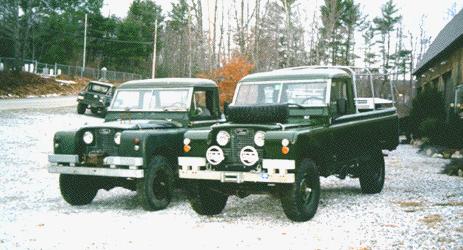
In this image you can see the slight increase in suspension lift on our
test 109s.
Typically about 1.5 inches with standard rate parabolics.
(Stock leaf 109 on the Left, Parabolic 109 on the Right)
Is there a down side? We have been testing parabolics for quite
some time now. We can not currently see a down side. They can be set up
to carry heavier loads than the stock springs. They are built to the highest
standards and have passed our rigorous tests. We fully guarantee your satisfaction.
Body roll may be slightly increased due to the suspension actually being
able to flex (unlike stock springs), but the improved shocks offered with
the conversion offer an even better ride.
Parabolics put to the test:
The most effective way for you to experience the best parts about parabolic springs is to drive your Rover with them installed. The ride and handling benefits you will receive will leave you wondering why you didn't do it months ago. We know the differences they make, we have been driving them for some time now, but that is hard to translate into words without sounding like a sales pitch. So we have put together our findings in a more scientific approach so that you can see actual results without driving the vehicles.
We compared a stock 109 pick up (stock leaf springs) to an otherwise stock 109 pick up (with parabolic springs) to a coil sprung 109. The stock 109 and the parabolic 109 were vertically identical. They both had military shackles, 2.25 engines, etc. so they were as close as we could get to equal test platforms. The coil 109 was a V8 Station Wagon, but we just tested it for comparison.
All the tests were done at ECR on our 23 degree RTI (ramp travel index) ramp. The RTI scores are good for a comparison of the suspensions, but the real benefits are seen during daily driving and in off road situations, and RTI test is not a true definition of how a suspension works in all situations.
Tests on 88" Land Rovers have given us similar results.

This is the SIIA 109 with stock leaf springs. It scored a 376 on the ECR ramp.
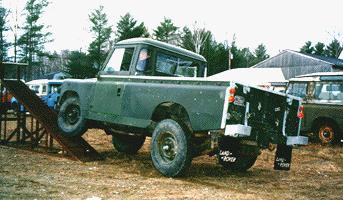
Notice that the stock springs move very little and that the rear axle downward travel or "droop" is almost non existent. As the 109 goes up the ramp the rear wheel lifts and traction is lost. This shows how a Rover with stock spring would act on the trail, and why those bumps and pot holes feel as harsh as they do. With this little flex in the suspension all those bumps are sent into the vehicle, and are not absorbed by the springs and shocks as they should be.

This image shows the SIIA 109 with parabolic springs. It scored a 417 on the ECR ramp.

Here we can see that the parabolic suspension is flexing nicely. The rear wheel is drooping out of the wheelwell and the front is starting to compress to allow for good articulation. This will be of great benefit on the trail, and with a suspension this flexible, the ride on the street will be greatly enhanced as well.

In this test we have added the manufactures shock absorber updates to the parabolic 109 and increased its RTI score to 440!!
UPDATE: !EXCLUSIVE!
ECR has now researched even better shock updates for the Ex-Military 109s! With our new kit installed the 109 pick up increased its RTI score to 510!!
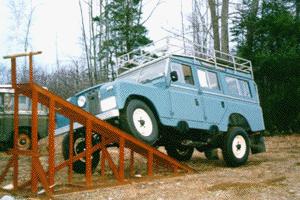
This image shows the SIIA 109 with stock coil springs. It scored a 550 on the ECR ramp.
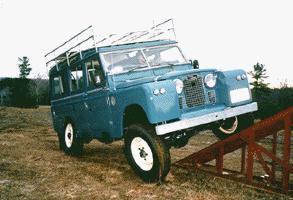
With some of the available coil sprung suspension updates you could go much farther with the coil 109, but the costs of a coil 109 are far greater than those of installing parabolics on your existing hardware. For the ultimate in ride, safety and articulation we still suggest coil springs, but parabolics are a great leap for stock Rovers, and they make a world of difference from the standard leaf springs.
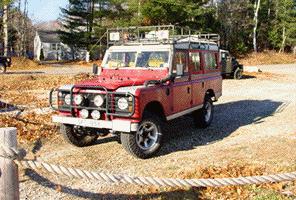
To see a typical parabolic spring install on a Stage 1 109" Wagon , go here.
Parabolic 88" Land -Rover Test:
If you apply all the same findings above in the 109 tests to
the 88" Land-Rover you know that the new suspension is going to give
you a better ride and better articulation. The parabolic springs really
shine on the 88" Rover as it is smaller and more nimble off road.
The 88 is also more common in the USA and a lot of people use them for
daily transportation, so parabolics make a great upgrade for these 88s.

In this image you can see that installing parabolics on your 88" Rover
will not drastically change its looks, or ride height. We have found that
everything about the suspension is far superior to the old system. The
Late SIIA 88 above has 2 leaf parabolics front and rear. It sits correctly
and rides like a dream come true.
The RTI tests of this 88 show much the same results as the 109.

This images shows the 88 (with 15" wheels by the way) on our RTI ramp.
(23 degree ramp). The 88 had the shock updates as well as the parabolic
springs and with no other modifications over stock it scored a fantastic
525!

The front axle of the 88 has roughly 6.5" of travel.

But the real story is in the rear, where over 12.5" of travel are
found. Check out that flex!
As with the 109 tests, we have found that driving the 88 for long trips
and around town is greatly improved and the new system makes improvements
in all areas with no down side. We were just as comfortable putting this
88 into corners at speed as we are with standard leaf sprung 88s. It is
much like driving a Discovery. The Disco does lean from side to side a
bit, but it isn't going to fall over and the benefits are worth the few
minutes it takes to get used to the new ride.
You'll wonder why you didn't install these springs years ago after your
first trip around the block!
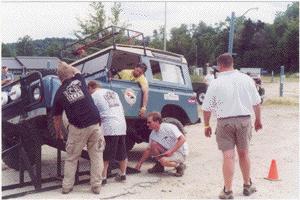
In this image you can see the 88" Rover, equipped with parabolic springs, that won ECR's Mini-Twist Off at the RoverFest 2000 event. This was the best flexing Series Rover at the Event. Congratulations to the owner, Bruce Kinzer!! He took home a Warn winch recovery kit, compliments of ECR, for his efforts!
Parabolic springs are offered in various spring rates and for both 88 and 109 Series Land Rovers. We can set up the springs to your exact needs with the correct weight settings and the correct shocks for your particular Rover.
Pparabolics will also make your Rover sit correctly and look great no matter if you have a stock 1960 Series II 88" or a 1983 Series III 109" Ex-MOD!
We also have all the shock updates available for Ex-Military 109s with parabolic springs!!!
Spring are for in shop install. We do not offer mail order parts or suspensions.
For all of your Land Rover suspension needs contact
ECR.
If you would like the world's best parabolic springs for your 1965 SIIA
88, or a Stage III conversion to your 1995 LWB Range Rover... ECR is your
source.
Let us know how we can help make your Rover better.
Back to the Series II-IIA-III Section
Back to the Table of Contents
East Coast Rover Co.
Contact Information